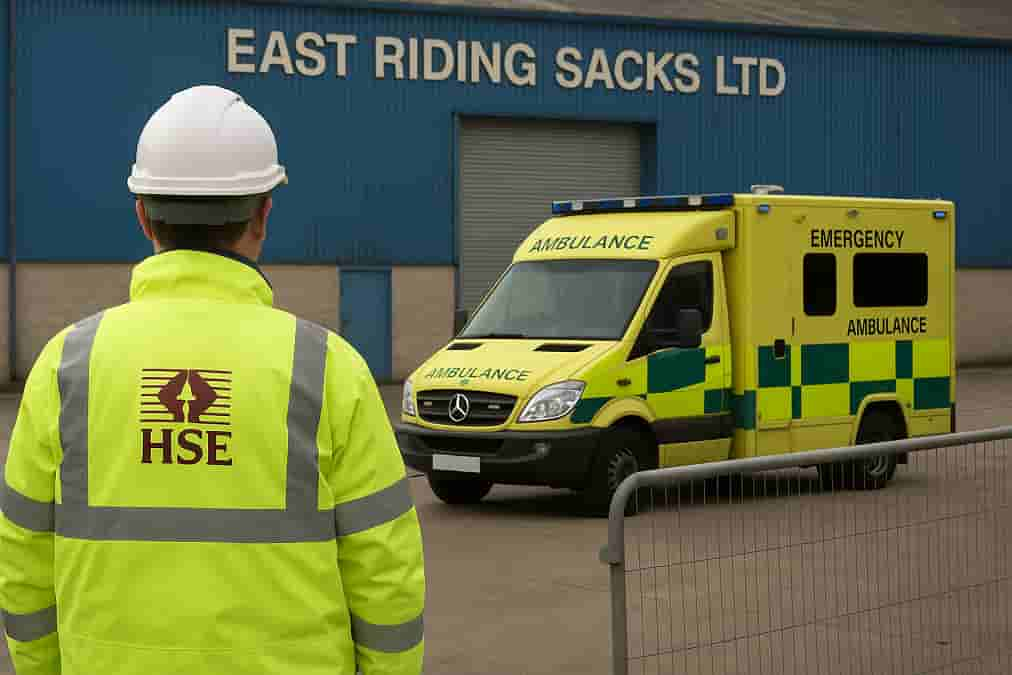A tragic workplace accident has led to a substantial penalty for a UK-based packaging manufacturer, after serious safety failings resulted in the death of a worker.
East Riding Sacks Ltd, a manufacturer of paper sacks operating out of Stamford Bridge near York, has been fined £533,000 and ordered to pay £6,066 in costs following the death of Mark Pinder, a 51-year-old worker from York. The incident occurred on February 11, 2023, while Mr Pinder was working on one of the company’s production lines.
According to details presented at Hull Magistrates Court on April 30, 2025, Mr Pinder had been addressing a blockage on the upper deck of the machinery. During this process, he stood on stationery metal rollers to remove the obstruction. It was then that the machinery was partially reactivated, causing him to lose his footing. He fell approximately three metres from an unguarded edge, landing on the concrete factory floor below. Despite the swift arrival of paramedics, Mr Pinder was pronounced dead at the scene.
HSE identifies major safety failings
A thorough investigation by the Health and Safety Executive (HSE) revealed multiple breaches of essential safety protocols by East Riding Sacks Ltd. Notably, the company had failed to implement a robust safe system of work around both the isolation of machinery and the removal of blockages.
The report also noted that fall risks had not been adequately assessed, and there were no effective measures in place to prevent such incidents from occurring. The area from which Mr Pinder fell had an unguarded edge, exposing workers to unnecessary danger. According to the HSE, falls from height remain one of the leading causes of workplace injuries and fatalities in the UK.
Further findings revealed that it was routine practice for staff to clear machinery blockages without proper isolation. Workers had come to rely exclusively on interlock guarding—a system that should have served only as a secondary safeguard. Crucially, staff had not been given adequate training on how to safely isolate machinery or remove obstructions.
Perhaps most alarmingly, workers were also found to be using conveyor belts as shortcuts between gantries, frequently climbing over handrails to avoid using designated stairways. This unsafe behaviour had gone unnoticed by management, highlighting a wider issue of oversight on health and safety culture at the facility.
Legal outcome and expert comment
East Riding Sacks Ltd, located at Full Sutton Industrial Estate, pleaded guilty to breaching Section 2(1) of the Health and Safety at Work Act 1974—a key section of legislation requiring employers to ensure, so far as is reasonably practicable, the health, safety, and welfare of their employees.
Following the court hearing, HSE inspector Elliot Archer issued a stark reminder to employers across the country:
“Every year, a significant proportion of workplace injuries and accidents, many of them serious and often fatal, occur as a result of people accessing dangerous parts of machinery and working at height.
“Where access beyond machinery guarding and safety devices is required for the removal of blockages, robust isolation procedures to remove all sources of power should be implemented alongside a suitable safe systems of work.
“Had these been in place, and the recognition of work at height being undertaken been flagged by the company, with appropriate controls implemented, this incident would have been avoidable.”
The case was prosecuted by HSE enforcement lawyer Karen Park with assistance from paralegal officer Lucy Gallagher.
A call for heightened vigilance in UK workplaces
This incident serves as a tragic reminder of the devastating consequences that can result from lapses in health and safety law. It also reinforces the importance of comprehensive risk assessments, adequate staff training, and a safety-first culture that reaches from factory floors to management offices.
The Workers Union Says…
“Employers are reminded that working at height should be avoided wherever possible, and if necessary, must be subject to stringent control measures. In addition, access to dangerous machinery should always be prevented unless all energy sources are safely isolated, and the area has been rendered secure. The HSE provides detailed guidance on working safely at height, machine guarding, and lock-out/tag-out procedures, and it is imperative that companies across all sectors familiarise themselves with these best practices to protect their workforce.”




